45 ‘Super-Fly’ Species Of Insects That Changes How We See Creepy Crawlies
Thanks to the thousands and thousands of enchanting wildlife and plant species that cover the world, the world never ceases to amaze. A group of wildlife creatures that, let’s face it, is not nearly as popular as the rest, especially the mammals. We understand. Many people do not like the feeling of something creepy crawly on their skin, let alone get near them. This is especially the case if they have no idea what kind of insect it is. They may ask themselves, “Does it bite?” or “Is it poisonous?” These are legitimate questions. However, while insects can just be a bunch of scary-looking bugs, they also have some incredibly eye-catching species within their family that definitely deserve some recognition. Enjoy from afar some of the most notable bugs people have ever come across!
The Orchid Mantis
No, your eyes are not deceiving you here. While the Orchid Mantis might look like a natural flower, it is, in fact, very much an insect. It is no surprise that because of its appearance that it is part of the flower mantis species.
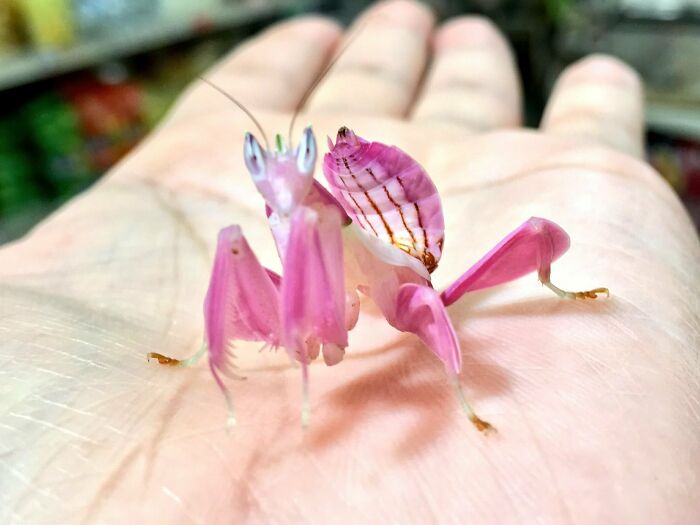
While the Orchid Mantis is mainly known for its bright pink and lavender coloring, they can actually change their color to better blend into their environments, taking on shades of whites and browns within the rain forests of Southeast Asia.
The Ermine Moth
Just like the Orchid Mantis, the Ermine Moth could also be considered a master of disguise and could easily blend in as a member of the royal family. Well, it would blend in with their ermine fur coats if we’re being realistic.
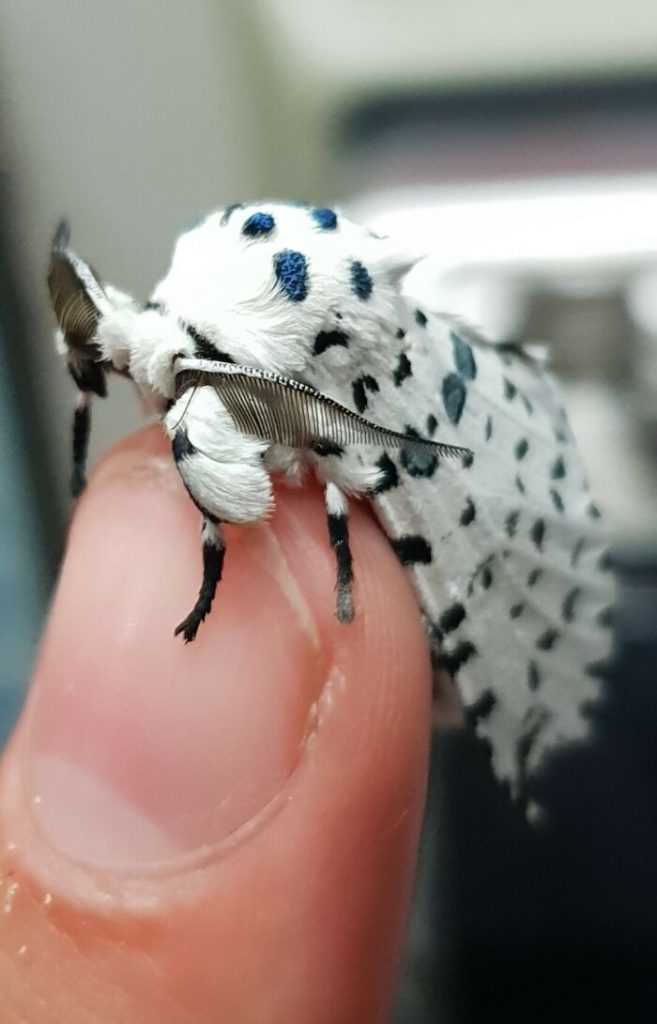
These dashing little fellas are generally on the tiny side, with wingspans only reaching between 8-30mm in length. Dazzling appearances aside, the ermine moth is also somewhat of a pest for farmers due to them laying their larvae within the crops and plants.
The Northern, Blue-Banded Bee
Now, whoever expected to see a blue animal in real life, let alone a bee! Amegilla cingulate, commonly just referred to as a blue-banded bee, is a species of bee native to Australia — no surprise there. Are we right?
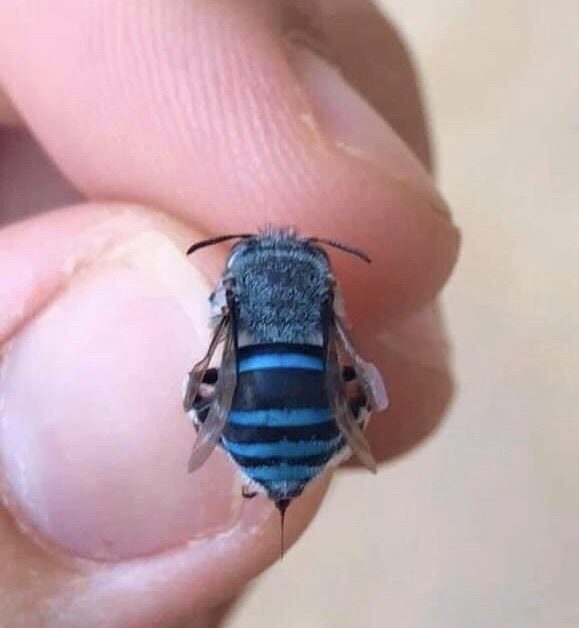
While the Blue-banded Bee is certainly “blue,” it is not as blue as the one shown in this infamous picture, as only the abdomen of the blue is blue, not the whole body. No one truly really knows what is actually in this picture.
The Leopard Moth
No, this isn’t another picture of the ermine moth, although it is a common mistake. What we have here is the giant Leopard Moth from Northern America, sometimes incorrectly called the dalmatian moth, and you can probably guess why.
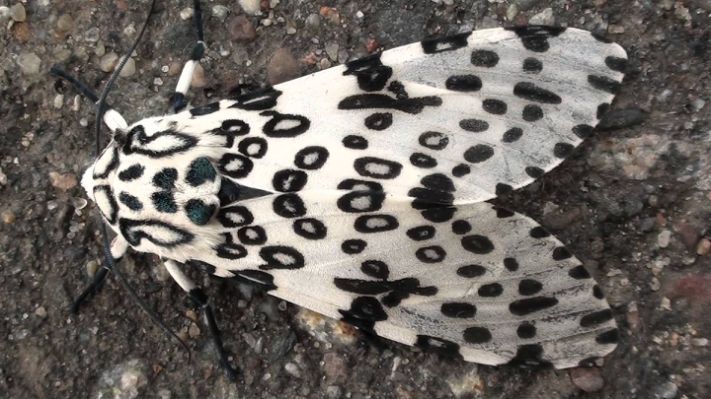
The Leopard Moth isn’t called a giant for no reason, absolutely dwarfing the ermine moth with its impressive 76mm wingspan and body lengths of 30-50mm. But chances are you won’t see one of them buzzing about on account of them being nocturnal.
The Young Spiny Flower Mantis
Don’t worry. This nightmare fuel creature isn’t an alien, although it could very easily look like one of those Zerg monsters from the StarCraft games. What we are actually seeing is a young Spiny Flower Mantis who hasn’t finished maturing.
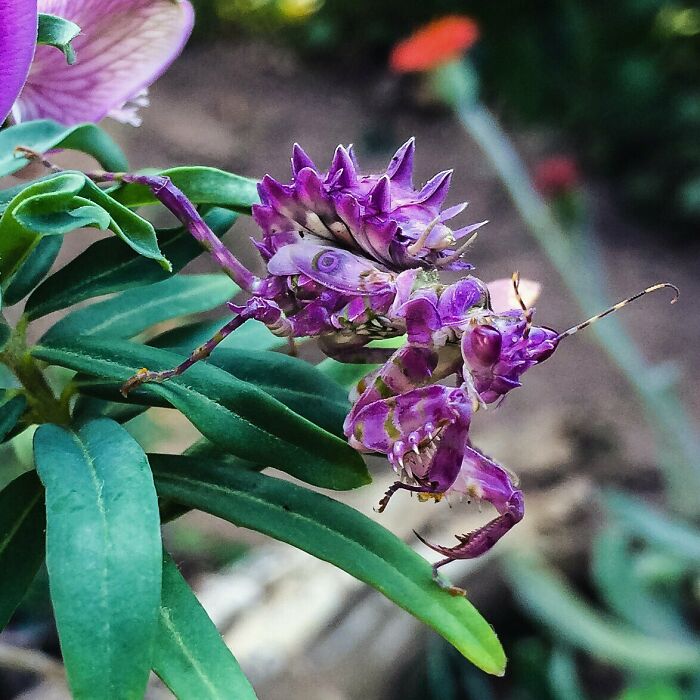
Commonly found around parts of eastern and southern Africa, the Spiny Flower Mantis is definitely a lot easier on the eyes once it has finished growing and doesn’t look like some kind of freckly skeleton-like insect made to frighten children… or adults.
The Steel Blue Ladybird
Sometimes, nature creates something so beautiful you struggle to believe it’s actually real. The steel blue ladybird is such an example. The ladybird has a bluish shimmering outer shell that almost looks metallic when the light shines on it.
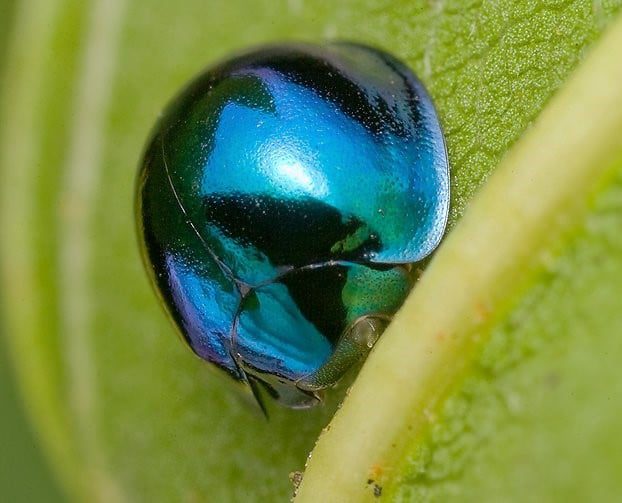
The Steel Blue is commonly found around Australia (native), where it is unsurprisingly a predator that feeds off smaller insects. It was later introduced to New Zealand in an attempt to tackle the insect problem that was damaging the crops.
The Spicebush Swallowtail Caterpillar
The Spicebush Swallowtail is an eye-catching butterfly that makes it home in North America. While it might certainly be a beautiful insect, we are actually here to see what its caterpillar form looks like and learn a bit about mimicry!
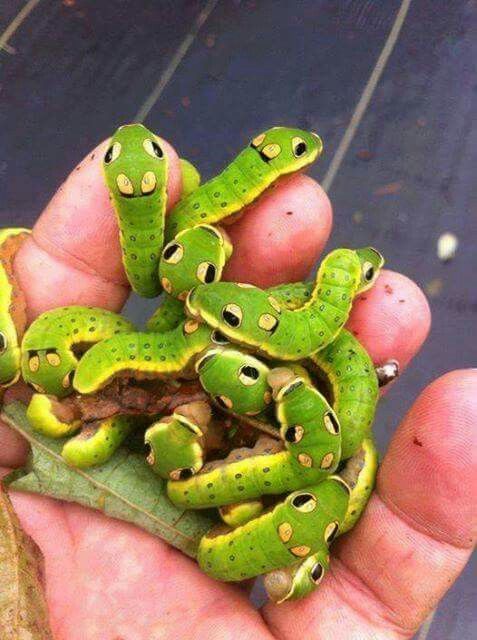
Both its larval and adult forms are able to avoid predators through the use of mimicry, which is where an animal takes on the physical characteristics of another animal as a disguise. With the larvae, in particular, they look like tiny snakes.
The Atlas Moth
When it comes to the world of lepidopterans (the family that moths and butterflies are part of), nothing comes close to the sheer size of the Atlas Moth, the largest in its family with a wingspan of 24cm and a surface area of 160cm2.
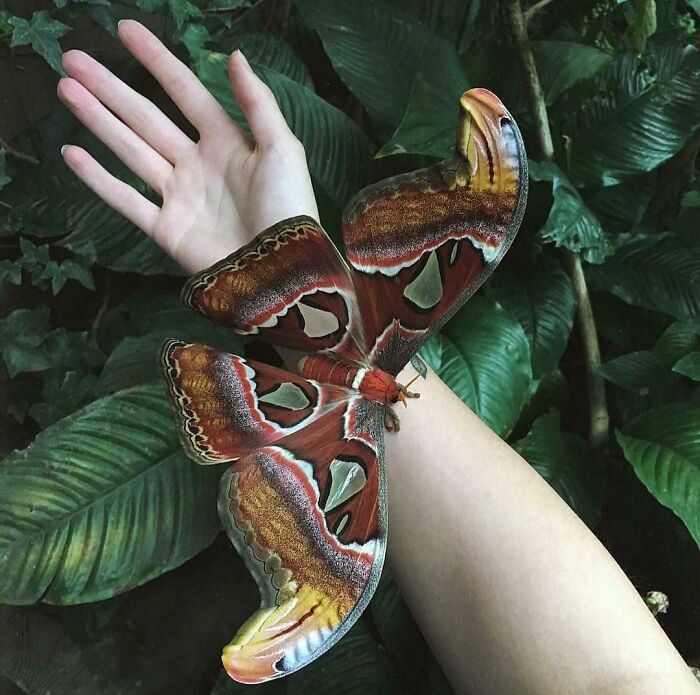
This giant, fittingly named after the Greek Titan of the same name, makes it home in dry tropical areas across much of South and East Asia’s forests. Wings aside, the actual body of the moth is much smaller compared to its wings.
The Rainbow Grasshopper
Wow! We’re not sure if the Rainbow Grasshopper looks fabulous or just plain annoyed. Either way, we are definitely steering clear of it! The Rainbow Grasshopper, also called the Painted Grasshopper, can be found all the way from Canada to Mexico.
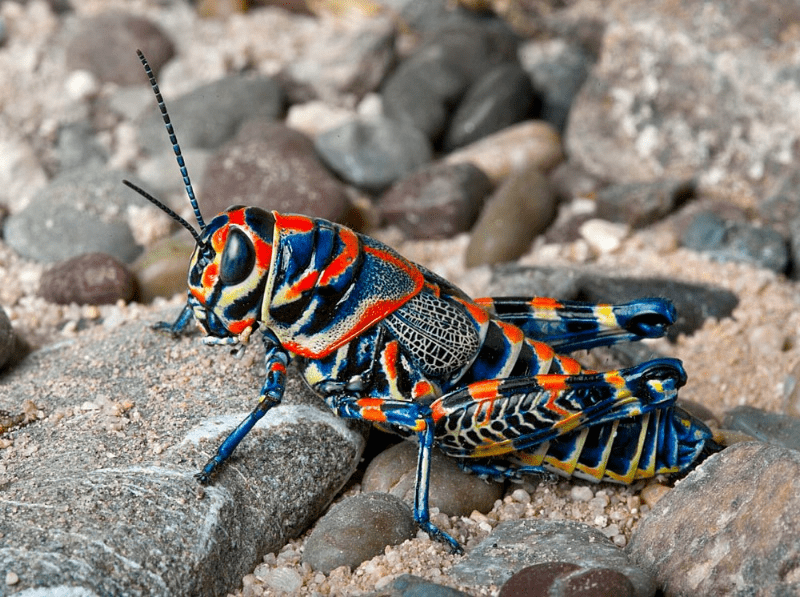
But, what’s really cool about these guys is that their unique colors are not just for show. This grasshopper is capable of aposematism, a biological feature that uses its coloration to frighten off potential predators, tricking them into thinking they are poisonous.
The Picasso/Zulu Hub Bug
The Zulu Hub Bug from the subtropical parts of Africa must be one serious fan of the arts. If its decorative and shielded back was not enough proof for you, it is also known as the Picasso Bug after the legendary Spanish painter.
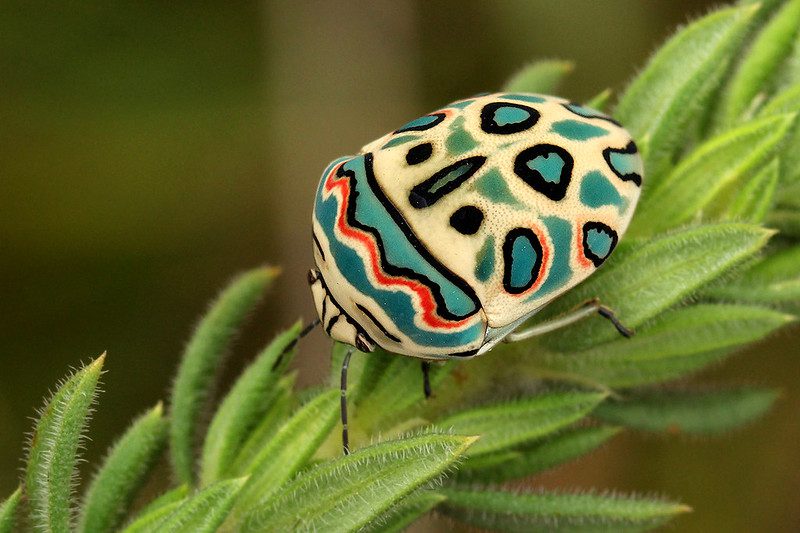
The colors of the Picasso Bug’s back form in such a pattern to create eleven distinctive ring-shaped spots. But same as with the rainbow grasshopper, its coloring also serves the purpose of acting as a warning for the noxious smell it can release.
The Prickly Stick Insect
Something tells us this guy might have a bit of a spikey personality. It is from Australia, after all. The giant prickly stick insect is a master of disguise and defense with a thorn-covered body that perfectly blends in with its environment.
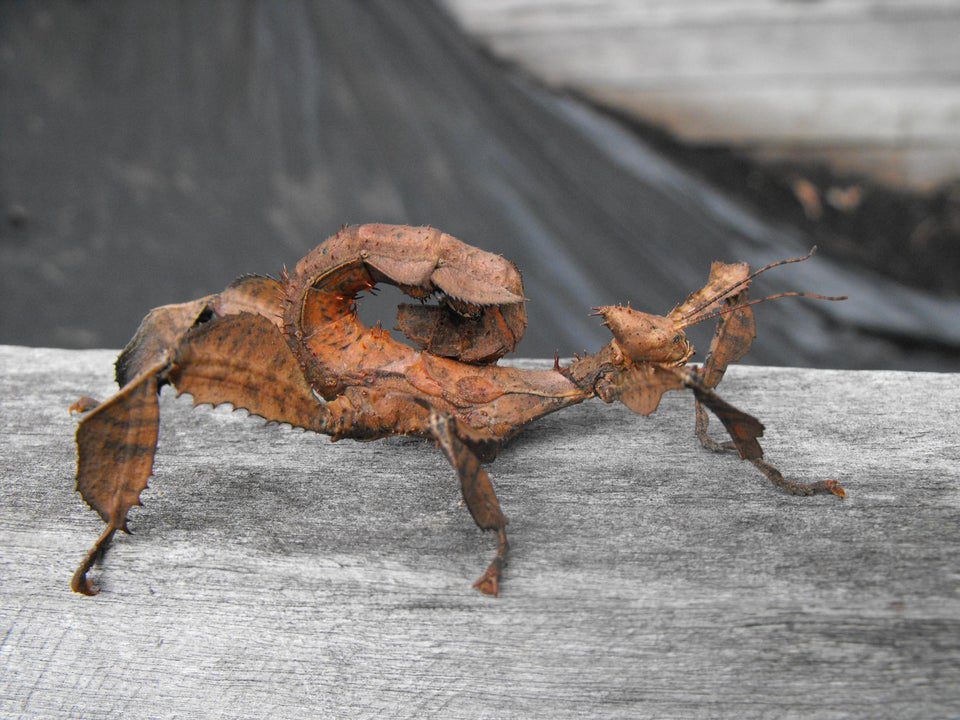
There is a big difference between the males and females of the species. The males tend to be much smaller and lack a lot of the thorns that the females have, but because they are smaller and thinner, they can actually fly.
The Fifteen-Spotted Ladybird Beetle
When we think of ladybugs, we usually tend to picture them with shiny red shells, probably because that’s how they also looked in cartoons. What people don’t always know is that they come in a lot of different colors.
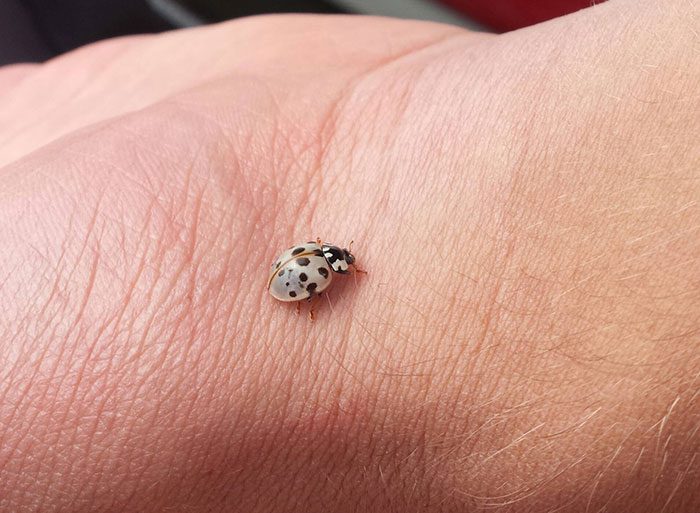
One of the most interesting kinds has to be the Anatis labiculata or also named the fifteen-spotted ladybird beetle whose shell can vary from light dirty grey to whites to dark browns. Besides that, not that much is known about them.
The Blue Featherleg
The Blue Featherleg, also known as the White-Legged Damselfly, is not actually a mosquito or a dragonfly, even though it can look like one. They are instead damselflies, which are closely related to dragonflies and like to eat mosquitos and flies.
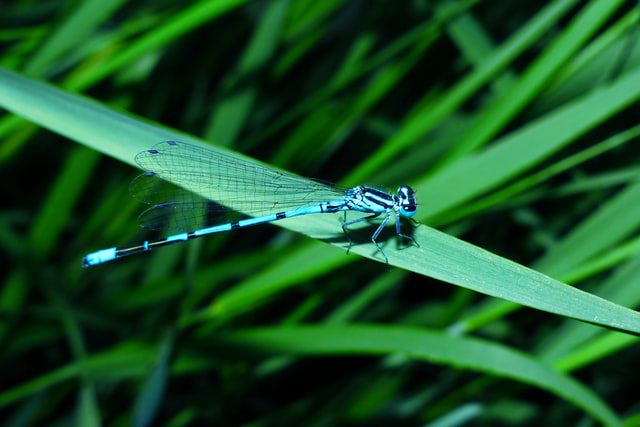
One thing is for sure: they are definitely enchanting to look at with their calm, pale blue coloring. They are also quite hardy and able to live around fresh lakes and rivers, and musty and foul-smelling bogs.
The Jewel Bug
It should be no wonder why the Scutelleridae is commonly called the Jewel Bug, thanks to their vibrant and shimmering outer shells that have an almost metallic-like quality to them. And like real jewels and gems, these guys come in dozens of colors.
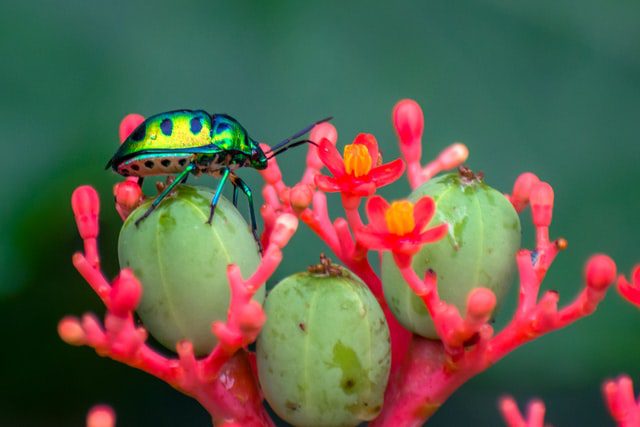
The name Jewel Bug doesn’t refer to one specific bug. Instead, it refers to a giant insectoid family that is believed to have over 450 species! Can you imagine the kind of nightmare their family reunions must be like?
The Rosy Maple Moth
The Rosy Maple moth Looks like something straight out of a fairy tale with its mix of brilliant and vibrant shades of pinks and yellows that color its hairy body. It also happens to be the smallest species of the silk moth.
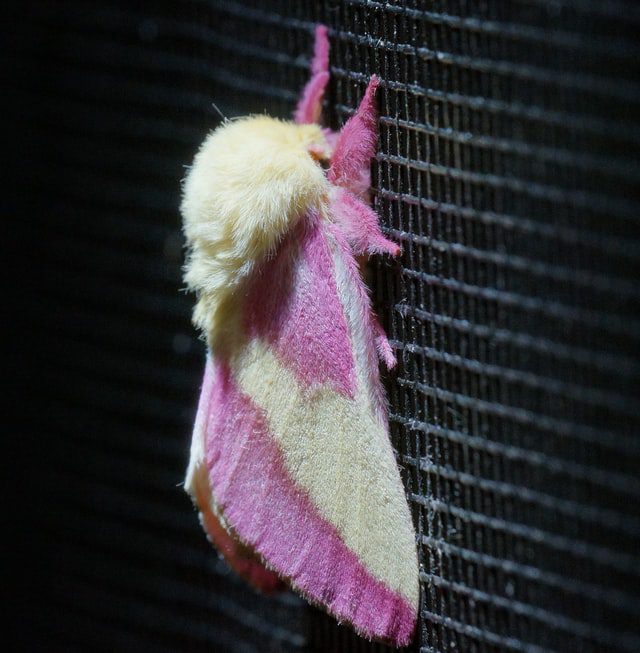
As you can guess from its name, the Maple Moth builds its home and nest along the branches of the maple trees, with the leaves of the trees doubling as a source of food for their larvae. The adults do not eat.
The Dogbane Leaf Beetle
While the Dogbane Leaf Beetle might have a pretty scary name, they actually are not a threat or danger to your furry four-pawed friends. The beetle gets its name from the fact that it lives off eating the Dogbane Flower.
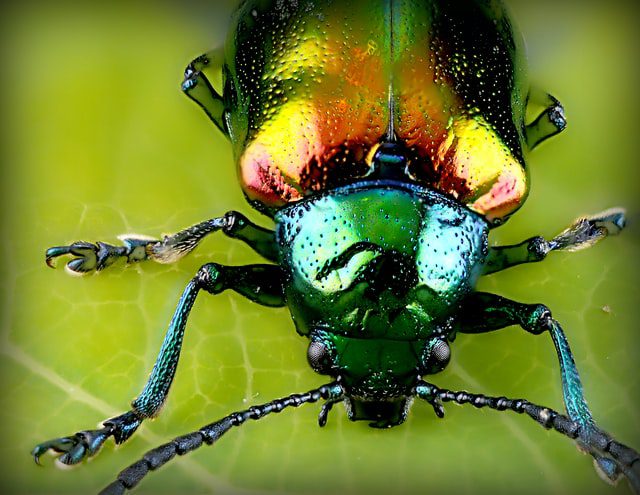
The Dogbane Plant, from North America and lower parts of Canada, is very poisonous, meaning the Dogbane Leaf Beetle is actually doing its job to combat this vile plant. There is no proven source of dogs eating the plant, if that’s what you’re thinking.
The Striped Bug
Now the striped bug, or scientifically known as the Graphosoma italicum, really knows how to create an impression and make a statement! It’s fitting, seeing as how the striped bug is native to one of the fashion capitals of the world — Italy.
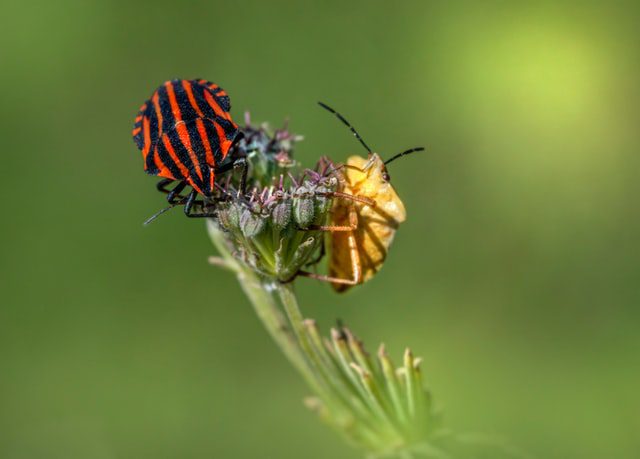
The body of the striped bug is mostly a mix of reddish-orange, further accentuated with black lines that run down its shell and abdomen that completely cover its legs. The striped bug can now be found all across the Mediterranean.
The Shield Bug
What we have here is the Green Shield bug, which, interestingly enough, is not green! This is normal, as this shield bug is known to adopt greenish browns and copper colors during specific seasons. It is commonly found around the British Isles.
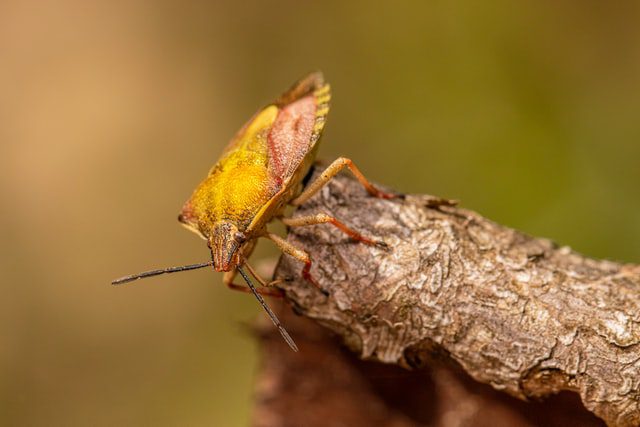
The Green Shield Bug is also part of the stink bug family, but they are not as offensive as actual stink bugs. The Green Shield uses its powerful scents and smells for communication and as a signal for potential danger.
The European Stag Beetle
You definitely do not want to mess with the European Stag Beetle and its impressive pairs of mighty mandibles. The Stag Beetle can be found crawling in large parts of Western Europe, specifically in the more mountainous and leafy areas.
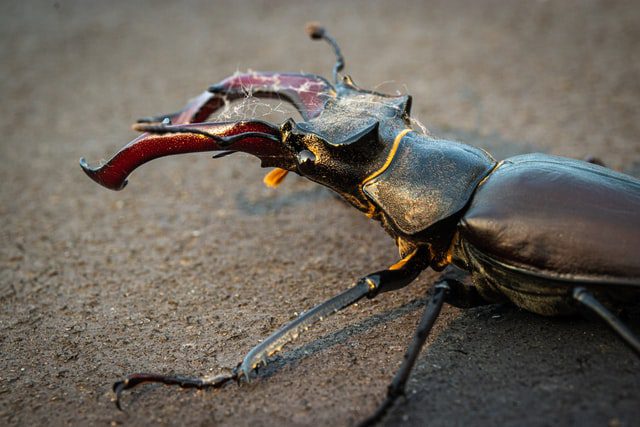
Interestingly enough, only the males of the species have those massive clippers that earned it its name. Even more fascinating and slightly funny is that their mandibles are actually weak, meaning you don’t actually have anything to worry about.
The Sacred Scarab
The Scarab, or more accurately named the Sacred Scarab, is another type of beetle. While the species are a form of dung beetle, that hasn’t stopped them from profoundly impacting ancient Egyptian mythology and becoming a holy symbol of their gods.
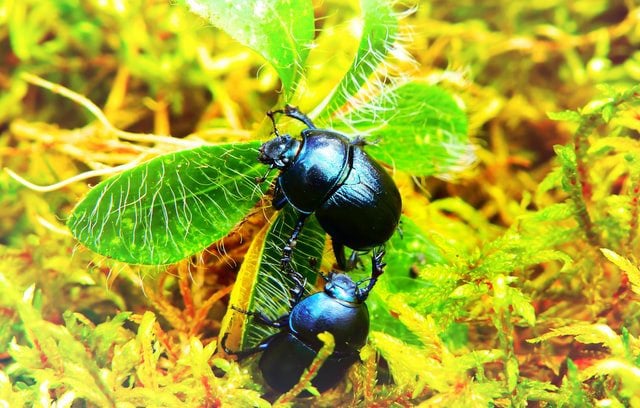
Egypt aside, the Sacred Scarab can be found along much of the Mediterranean Basin, where they make their homes on coastal shrubbery and dunes. While the Scarab is certainly cool, it’s still pretty gross that it plays with and eats dung!
A Close Up of a Ladybird
We’ve seen the captivating white-shelled fifteen-spotted ladybird, but what about plain, odd, and classic ladybird? Well, don’t worry because that is just what we have next, and not to mention it’s a super close-up photo of the little red-orange critter.
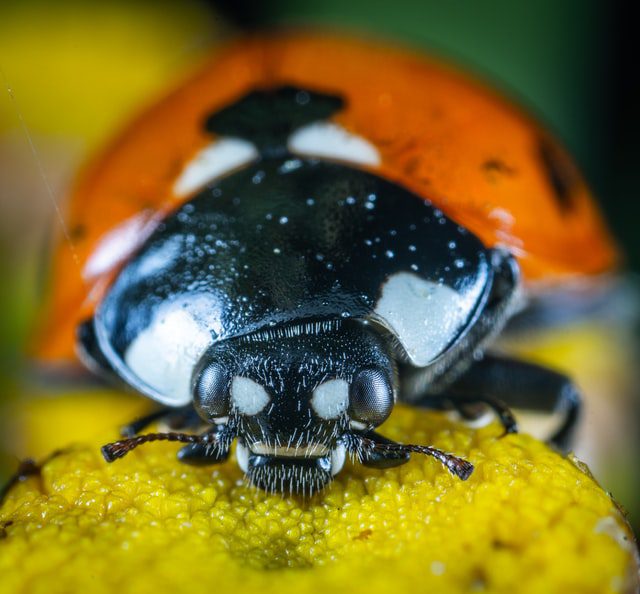
The power of modern technology allows us to really get a good look at these little guys and their surprisingly hairy faces. It almost looks like it has a mustache! At least this close-up is still cute because not all of them are!
The Rainbow Dung Beetle
If you thought the Scared Scrab was beautiful for a dung beetle, wait until you see the appropriately named Rainbow Scarab or Rainbow Dung Beetle. The Rainbow Scarab gets its name from the mix of dazzling colors that cover its body.
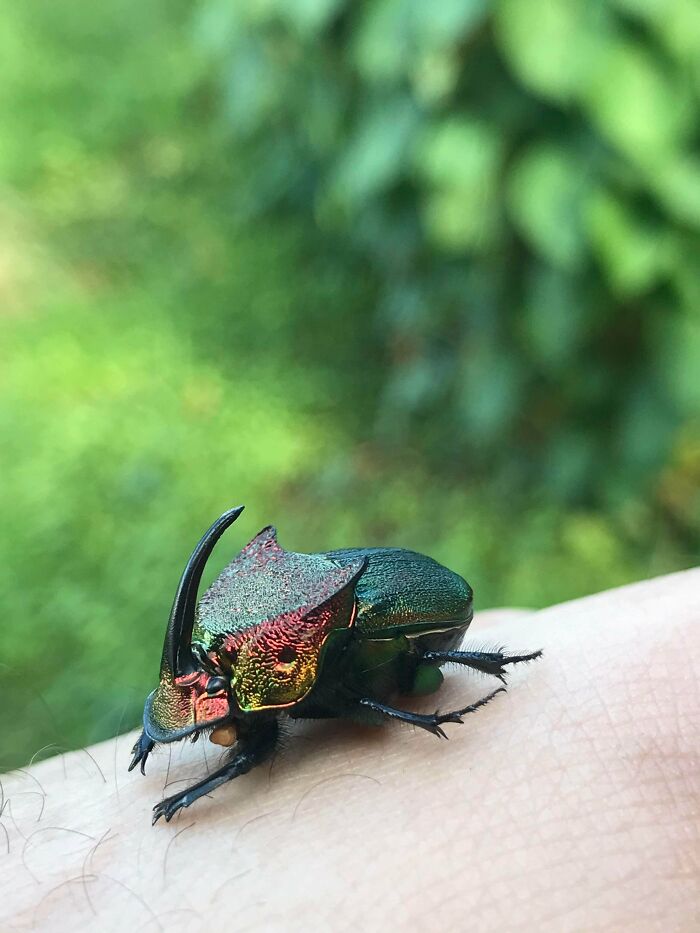
Each part of their bodies tends to have a different color of their own. Like all other dung beetles, they work together in pairs of males and females as they gather dung, all the while serving an important role in the environment.
The Glasswinged Butterfly
Butterflies already have a reputation for being some of the most amazing and whimsical insects you can encounter in the wild and around the home. Well, the Glasswinged Butterfly doesn’t fail to impress either, with its elegant yet simple appearance.
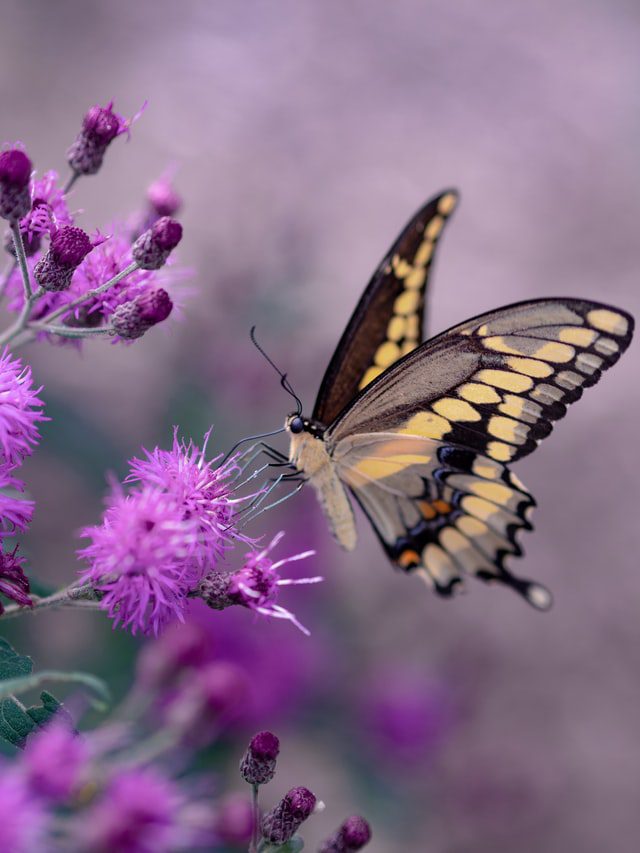
The insect gets its name from the fact that large portions of its wings are transparent while the outer edges are between a light brown/sand to a dark orange color, which makes it look like its wings have tiny glass windows!
The Mecynorrhina torquata
Commonly found around the nations of the DRC, Uganda, and other tropical parts of Africa, we have the Mecynorrhina torquata. This beetle is not only big but also breathtakingly beautiful. The Torquata is part of the goliath beetle family.
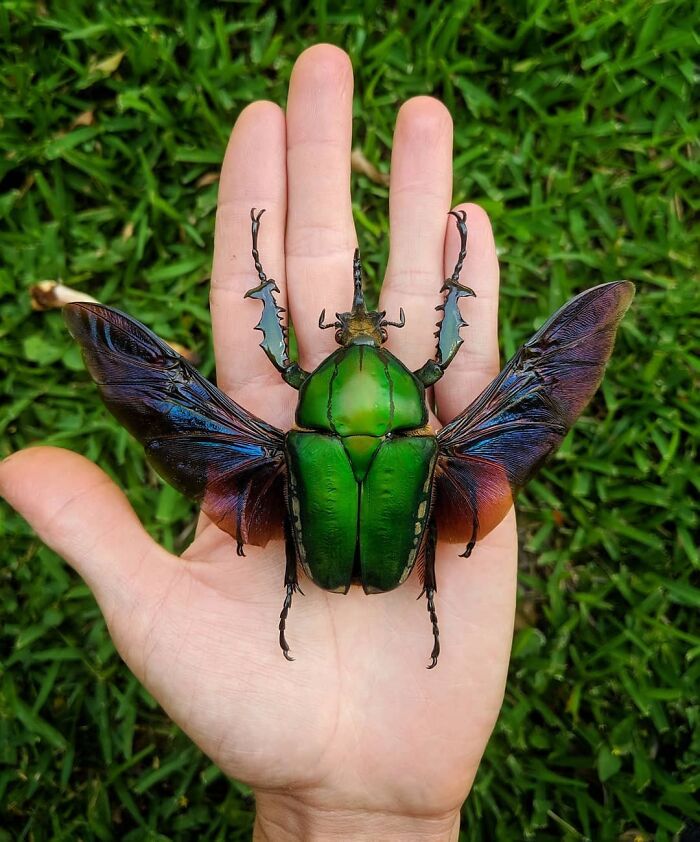
This means that the M. torquata is one of the largest species of flower beetle alive. They can reach lengths between 50-85mm depending on their gender, with the males are often easy to identify thanks to the horn atop their heads.
The White Ghost Cicada
If you have ever heard about cicadas, or even better, have seen some in real life, then you most likely know that they are famous, or rather infamous, for the deafening chirping noise they can make by beating their wings.
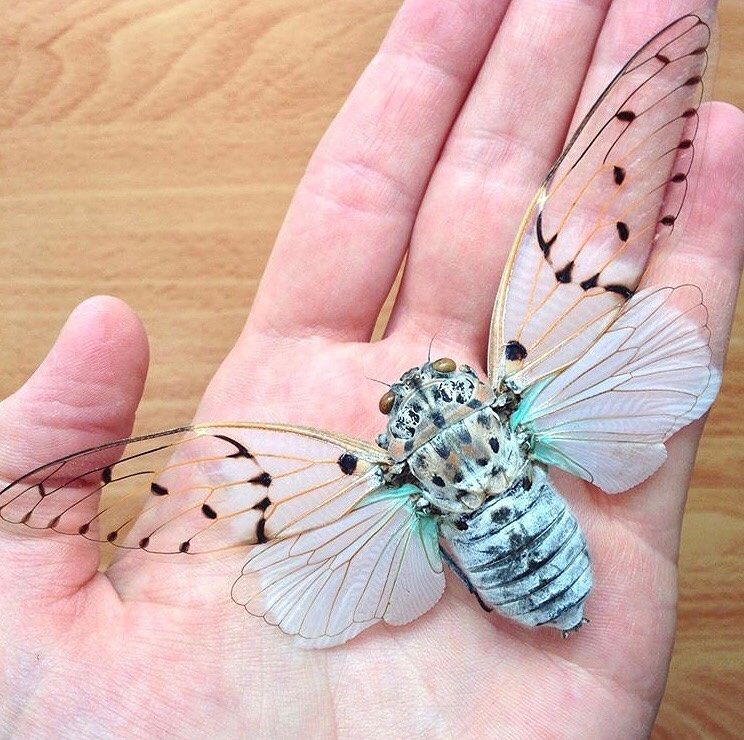
Cicadas are populous species and can be found in many places around the world. One such noteworthy one is the White Ghost Cicada, sometimes called the Milky Cicada. Awesome names aside, there isn’t much available and relevant information about them.
The Red Cotton Stainer
If we have learned one thing by now, it would be that there are some genuinely brilliant-looking insects around our fascinating world, and not just the gross kinds we grew up seeing and thinking about. The Red Cotton Stainer is definitely another stunner!
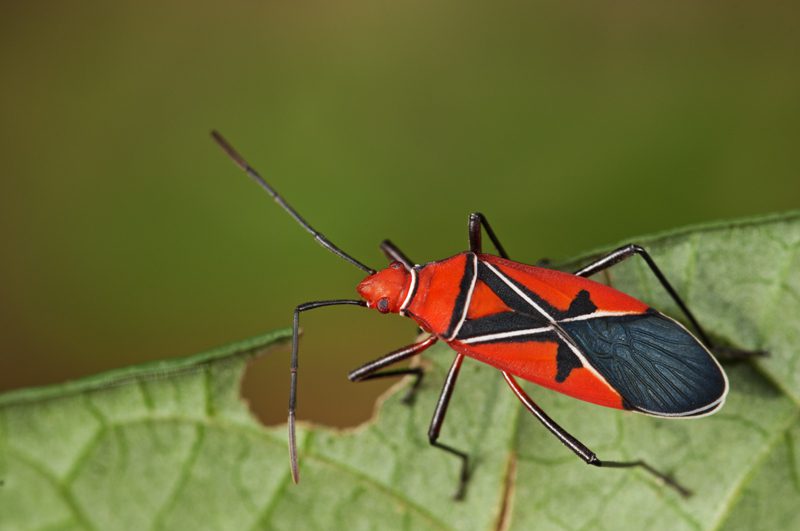
The Red Cotton Stainer gets its name from a few things. The first is the vibrant and various colors of reds and oranges that cover their bodies, sometimes forming patterns and masks designs. And the second is because they are pests on cotton farms.
The Oak Treehopper
Now, the Oak Treehopper isn’t necessarily the prettiest bug out there, but it is not the ugliest either. It’s just somewhere in the middle, with some of them having a brilliant mix of colors, and others not so much.
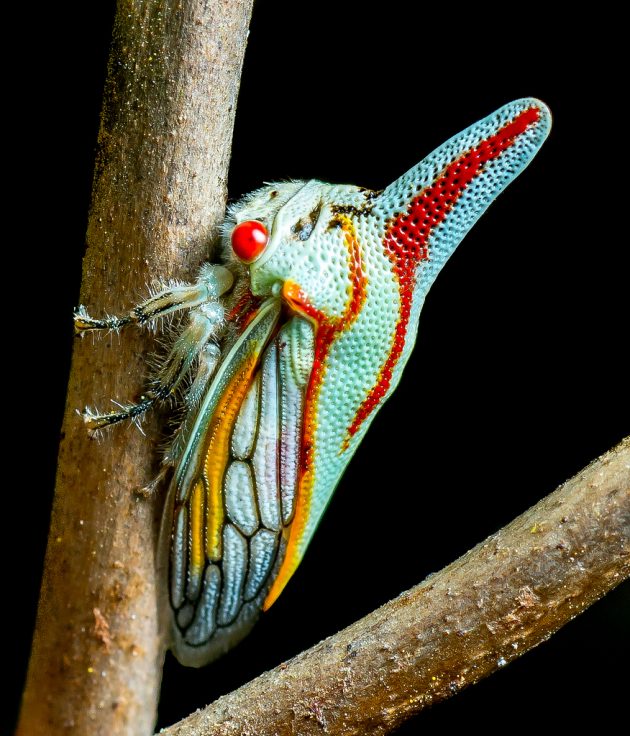
If anything, they are undoubtedly unique looking, like some weird mix between a giant moth and a beetle on account of its furry, winged body and horn-like appendage that can fold onto its back or shoot forward. Pretty impressive, we might say!
The Cotton Harlequin Bug
These colorful critters are often known as the Cotton, Hibiscus, or Harlequin Bug, a tiny bug of only 20mm and the only member of the Tectocoris genus. The Harlequin Bug gets its name (or names) from its unique contrast of colors.
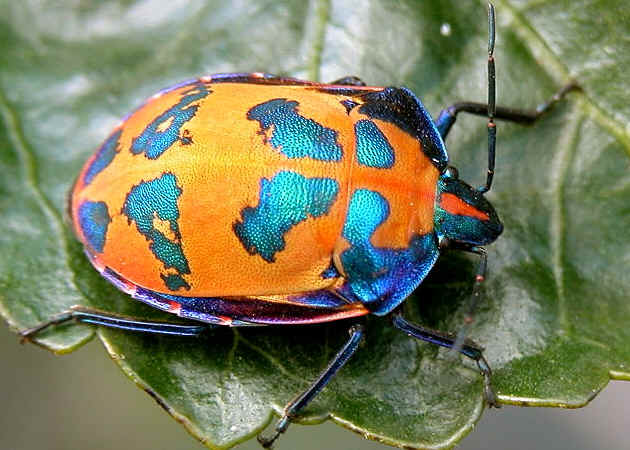
The females of the species are often orange in color with blue and black patches, whereas the males are the inverse, being blue-black but with red-orange patches. You can find these amazing critters along the Pacific Islands and parts of Australia.
The Black and White Weevil
Not much is known about this particular pest, and, yes, weevils are nothing but a pest! The only thing we do know about them is that they are supposedly, and plainly, called the Black and White Weevil for their distinctive coloring.
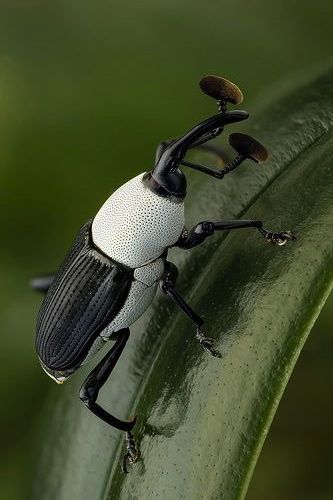
It is thought to be part of the genus Cercidocerus, which is part of the Curculionidae or “true” weevils family. They seem to prefer heavily forested areas such as around the Congo, where they were found using the hammer antenna as sensors.
The Nut Weevil
Fortunately, we do know a lot about the nut weevil, and just like all other weevils, they too are serious pests. The nut weevil earned its name from the fact that it lays its larvae within the nuts of hazel trees.
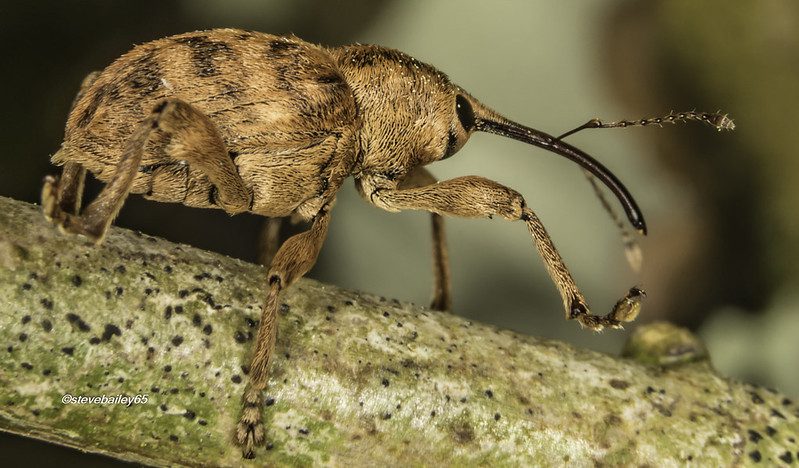
Commonly found across much of northern and central Europe, it could be said that the weevils also earned their names from the fact that they do also resemble actual nuts. That said, just make sure you don’t accidentally eat one!
The Cubaris Jupiter
This little creepy crawly is called the Cubaris Jupiter, a little unknown species of Isopoda which happens to be one of the most popular breeds to own. Guess we have to be in the Isopoda gang to get all the info.
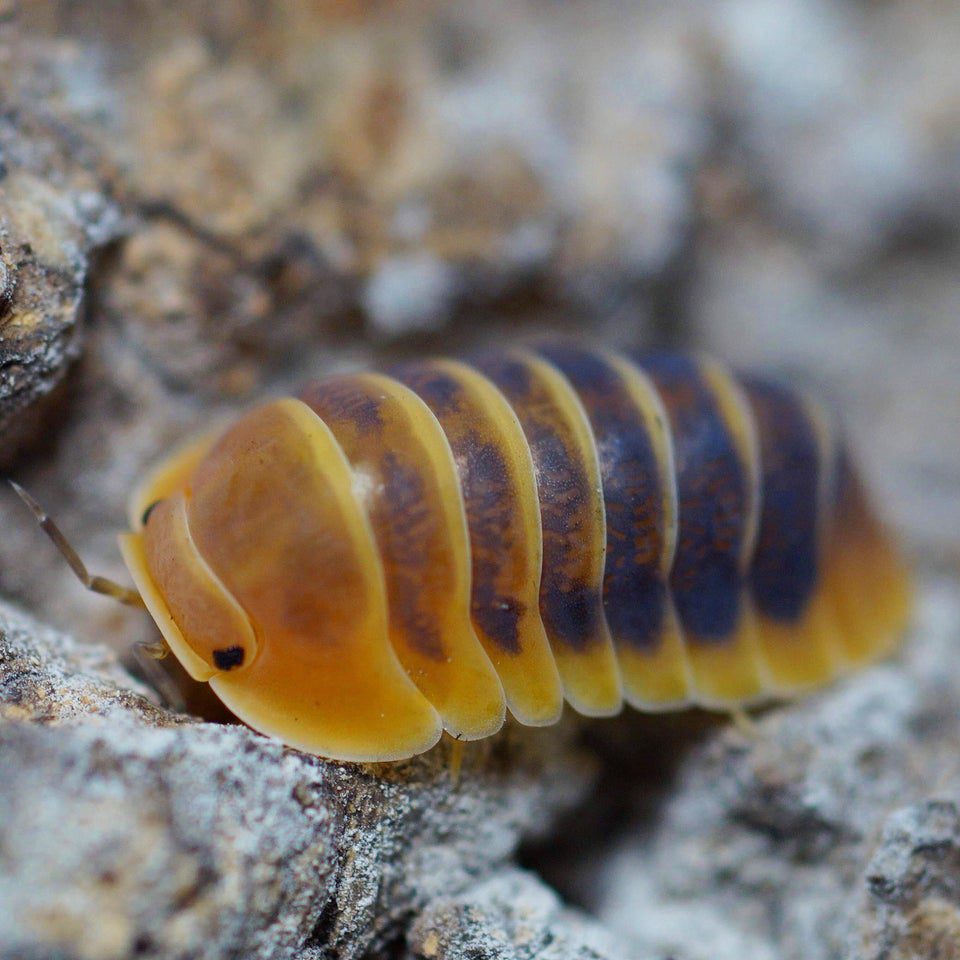
The Jupiter is originally from Asia, where they lived off of decaying plants and undergrowth and animal dung. A disgusting diet for sure, but an apparently healthy one for these little crawlers. No wonder they have been around for millions of years!
The Chlorocala africana oertzeni
This dazzling blue and purple critter is a species of flower beetle/chafer known as the Chlorocala africana oertzeni, which is native to Kenya and Tanzania. Their coloring is said to be dependent on the angle and lighting you see them in.
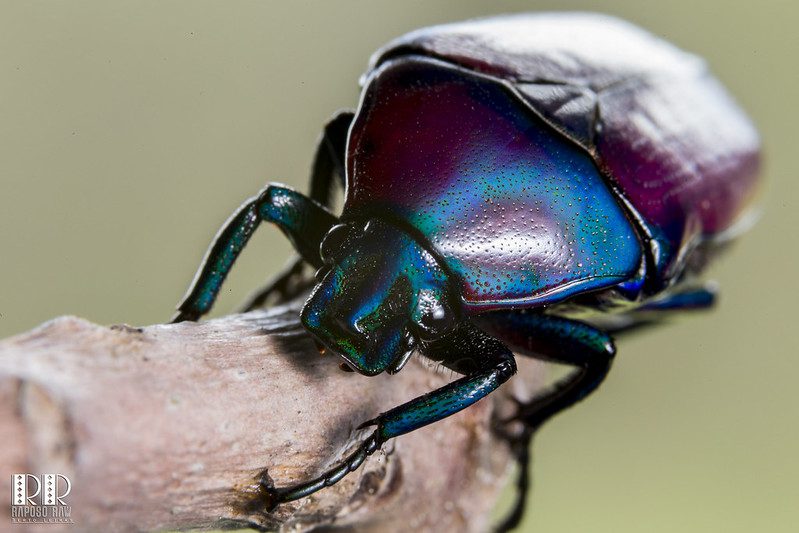
Like their other siblings, the C. oertzeni only reaches about 20-24mm in length despite how big you would think it would be, and it sustains itself by feeding on soft plants as well as their sap and only live for a handful of months.
The Imperial Tortoise Beetle
The Tortoise Beetle is truly one of the most beautiful species of beetle you are likely to come across, with the most common being the Golden Tortoise Beetle. That said, they are arguably outshined by their cousin, the Imperial Tortoise Beetle.
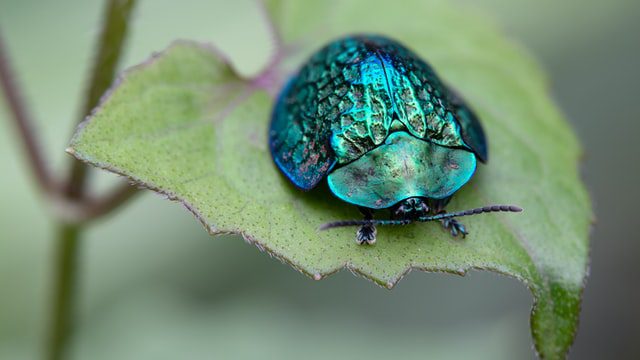
Unlike their beautiful golden shelled relatives, the imperial has a sapphire blue shell often accentuated with a gold-green mixture within the center. This beetle is found in Brazil and feeds off of various plants and different kinds of foliage.
The Flatida Nymphs
The Flatida tend to look rather unassuming when they are fully grown, often resembling something between a moth and butterfly, and can appear in a multitude of colors. However, the same cannot be said about them when they are still young.
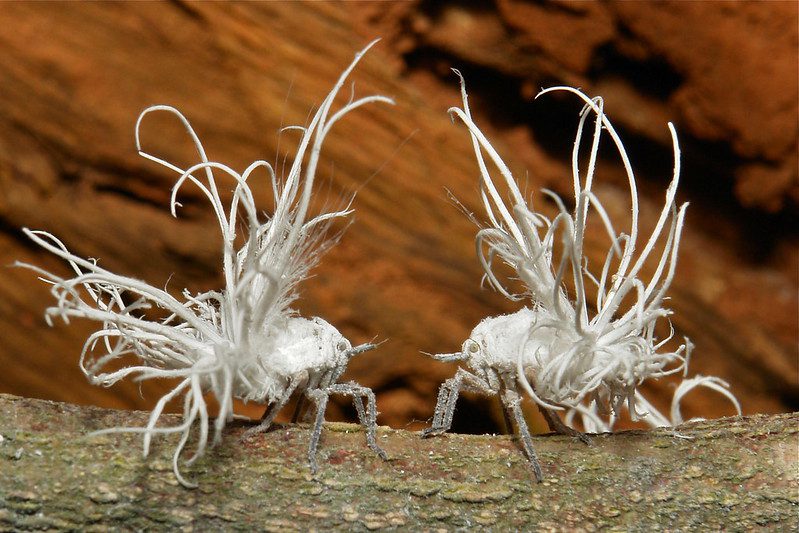
The nymph stage, meaning not fully grown or mature, of the Flatida could easily fit into a group of aliens thanks to its unsettling appearance, bone-white coloring, and dozens of branch-like limbs that stick out like a Sea Urchin.
The Hawaiian Happy Face Spider
Suppose you are ever looking for some inspiration for your next Halloween costume. Why not consider the Hawaiian happy-face spider who earned its name from splotches of black and red pigmentation on its abdomen that creates a smiling face.
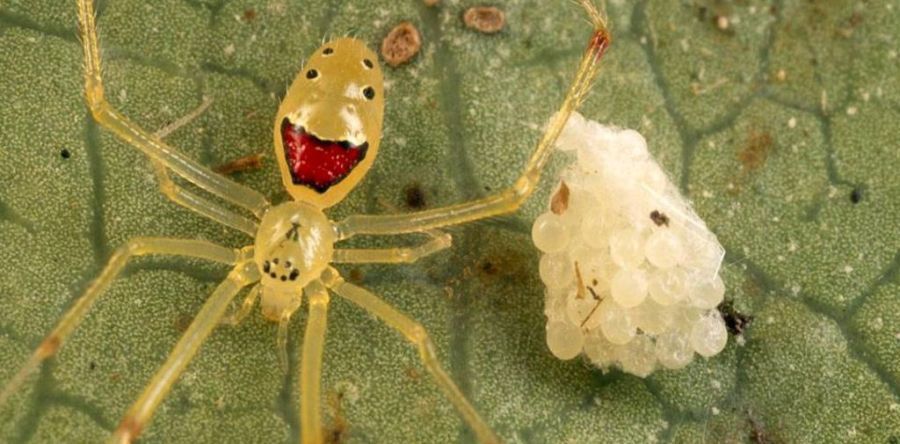
Besides the pigments on its abdomen, the rest of the spider’s body is a translucent pale yellowish color, which definitely makes the patterns pop. That said, their coloring and markings tend to differ depending on which of the Hawaiian Islands you’re on.
The Red-Nosed Lanternfly
Joining us from the lands of India and Thailand is the Red-nosed Lanternfly, a colorful and flamboyant species of planthopper, which funnily enough is related to the Flatidae. The fly has a long and distinguishable red snot that curves upwards.
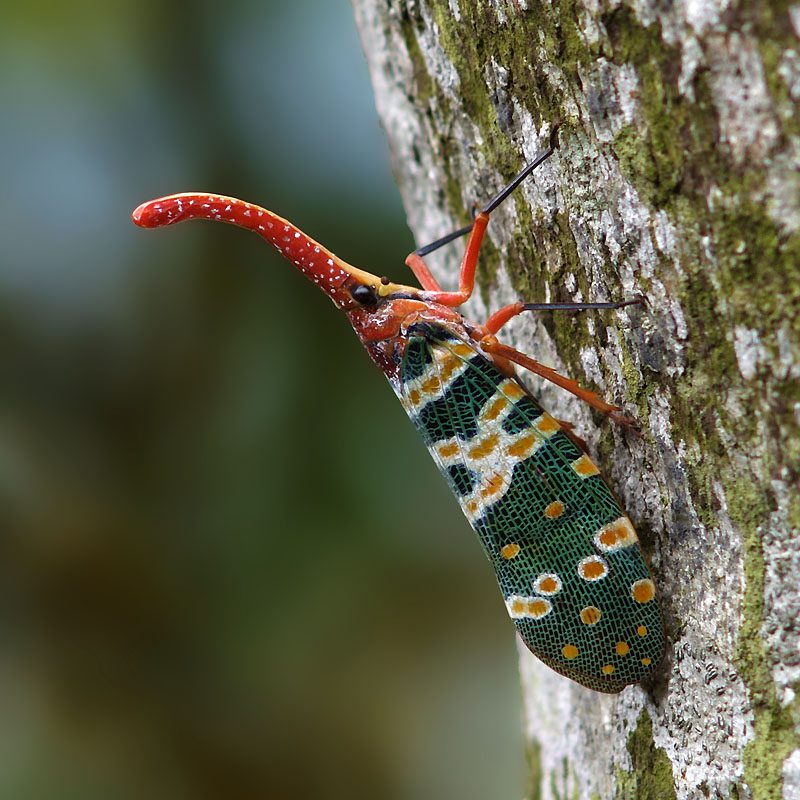
The color and shape probably reminded someone of a lantern, most likely. Its wings are also typically colorful, complete with vibrant spots and patterns that just seem to always work together. The Lanternfly feeds off of sweet plant sap.
The Jumping Spider
This fuzzy guy is probably one of the few spiders that are actually kind of cute to look at. The jumping spider is a part of a highly diverse family of spiders (with some of them not looking nearly as cute) numbering in the thousands!
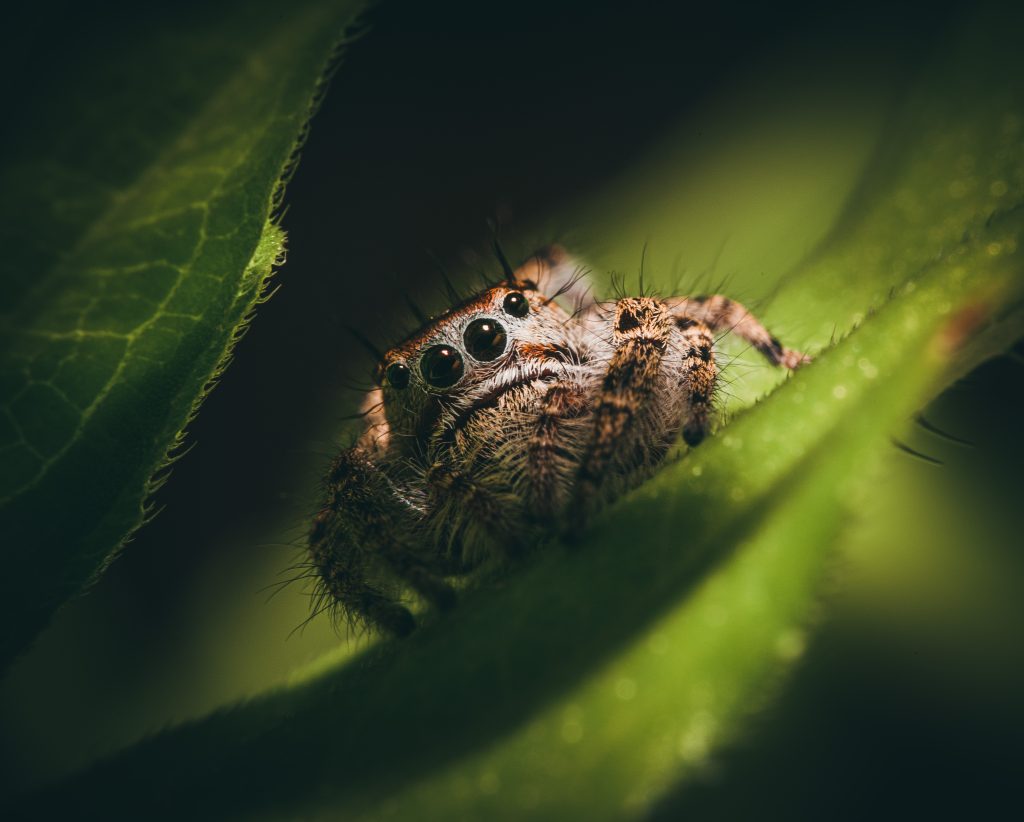
The jumping spider is a daytime hunter capable of performing really powerful jumps that literally tries to jump on its prey before biting down and releasing a quick-acting venom. Looks aside, they are still expert hunters.
The Giant Silk Moth Caterpillar
You have probably heard of or maybe even own some garments that said they are made out of silk. But how many of you know that silk is actually harvested from and made by the worm/larvae stag of silk moths.

This giant silk moth caterpillar, officially known as the Cecropia Caterpillar, is one big and icky-looking critter with dozens of spiky-looking knobs all over its green body. Surprisingly the caterpillar uses and releases its mildly toxic blood when threatened.
The Garden Fruit Chafer
Pretty sure these guys are tired of all the Black and Yellow jokes, but it is their most noticeable feature. The Garden Fruit Chafer also called the brown-and-yellow fruit chafer, is a fruit and planting eating beetle from Namibia and South Africa.
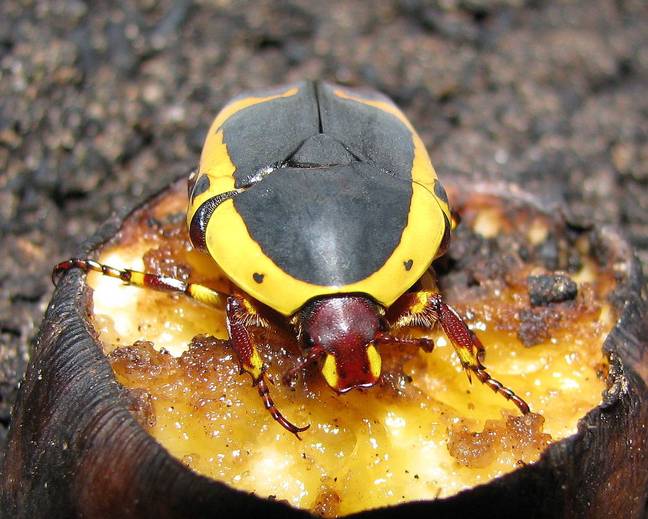
Unfortunately, the Garden Chafer isn’t a popular guest to have around gardens due to their tendency to destroy their prized flowers and roses. They are quite a popular snack for many birds, so keep that in mind if they are pestering you.
The Yellow Woolly Bear Caterpillar
The Spilosoma virginica keeps things simple with its almost fluffy white coloring. But, we aren’t here to talk about them. No, we are here to talk about its larval form, commonly called the yellow woolly bear caterpillar you see below.
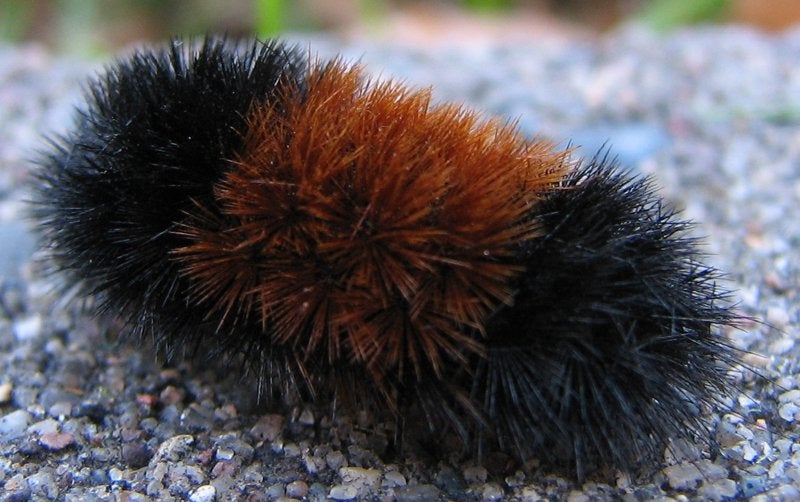
The caterpillar, as you can guess, is covered in sparse and rough-looking yellow, brown, and black hairs. They can often be found feeding on low-hanging plants and leaves. A mature moth can lay up to 100 eggs of those odd-looking things.
The Giant Lychee Stink Bug Nymph
These striking and odd-looking bugs are the nymph form of the lychee giant stink bug, a hated insect for the absolute damage that they cause to lychee tree farms in China. Their bright coloring is believed to make them look more dangerous.
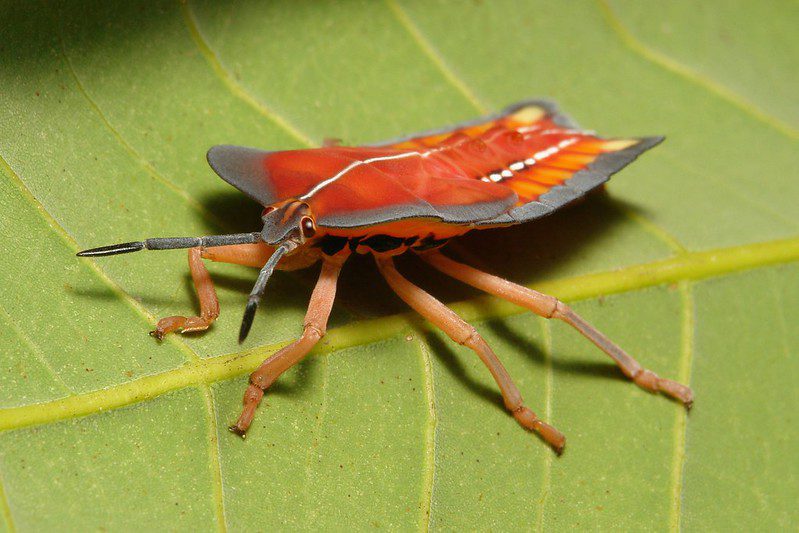
But if you and any predator decide to mess with them anyway, then be ready for them to squirt a foul-smelling and acidic liquid that can harm your skin and even blind you! They aren’t called stink bugs for no reason!
The Kudzu Bug
The Megacopta cribraria, more commonly known as the Kudzu Bug, is both a stink bug as well as a shield bug, making it quite the survivalist. Besides its foul-smelling stink attack, the kudzu is basically harmless, just not to crops.
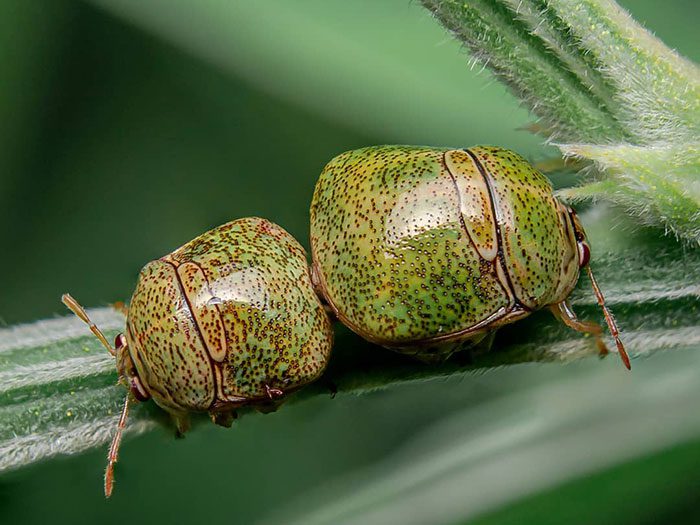
The kudzu is regarded as a pest by farmers due to the damage they can cause to bean crops and the plants of growing fruits and vegetables. Kudzus can often be found in homes because of their bizarre attraction to white surfaces.
The Twice-Stabbed Lady Beetle
We have seen white ladybugs, and we have seen the classic red-orange ladybugs, but what about a black one? Chilocorus orbus, otherwise known as the Twice-Stabbed Lady Beetle, is almost completely black save for two red dots on its back.
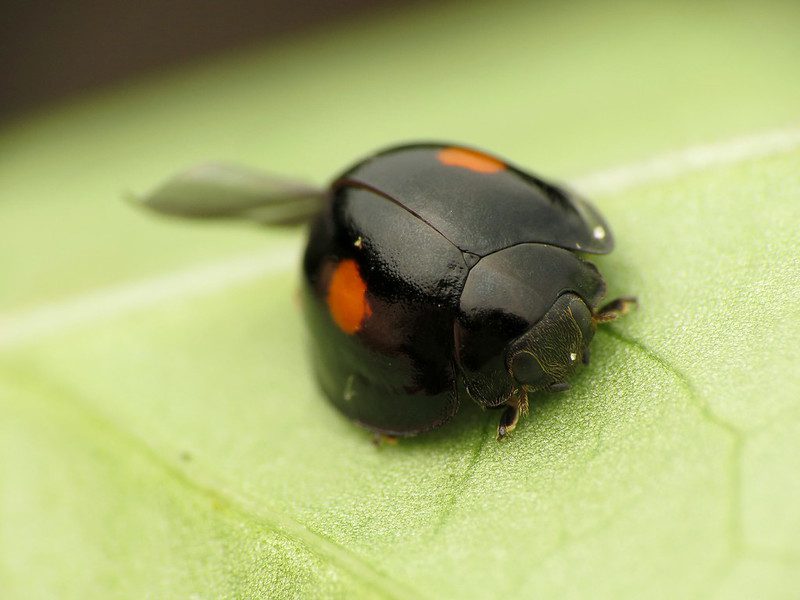
These black-shelled beauties are native to North America and particularly can be found in orchards, forests, and gardens. And just like other ladybirds, they are a gardener’s best friend, attacking and eating all of the scale insects that like to feed on fruit trees.
The Classic Bumblebee
Now for another classic, we have one of the flower’s most important workers and naturists, the Bumblebee. There are dozens of different bee species; the way you can distinguish the bumblebee from them is by their yellow and black fuzzy coats.
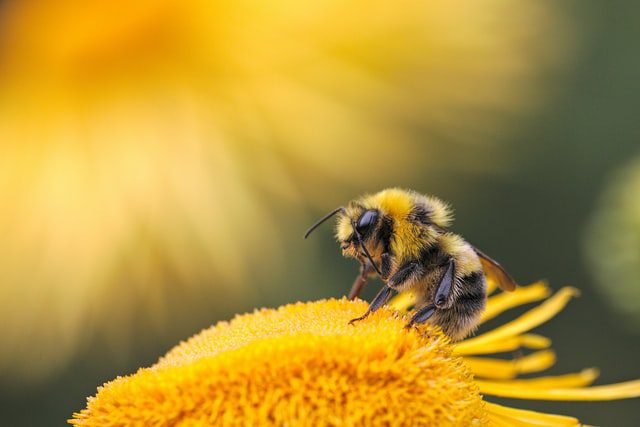
The Bumblebee is so important to the environment because they also help spread and distribute the pollen from one plant to another, completely unknowingly. This allows for the rest of the natural world to keep growing and creating new plants.
The Jewel Beetle
Buprestidae is the scientific name that describes a species of metallic-looking and shiny beetles commonly otherwise known as Jewel Beetles. The species are known and prized for their range and mix of shining and dazzling colors that decorate their outer shells.
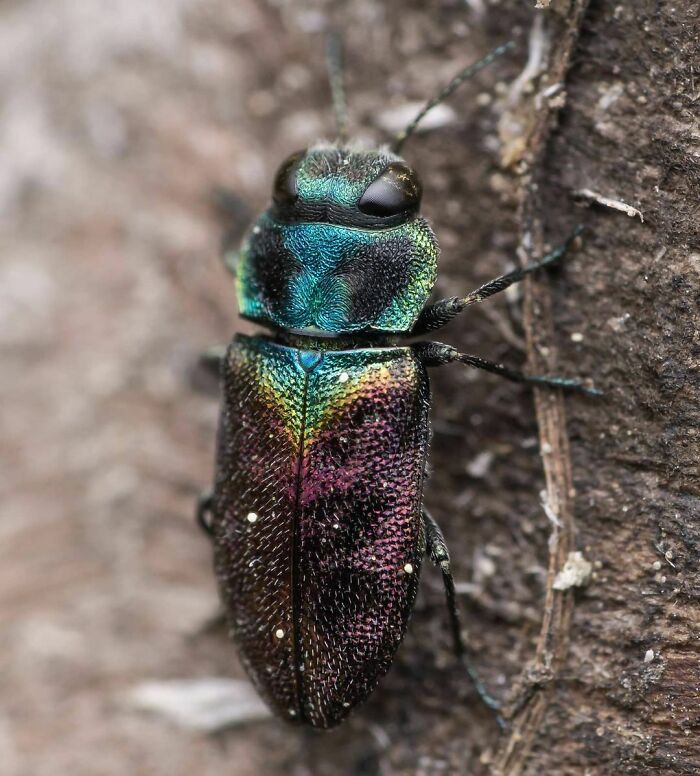
Because of their popular and desirable shells, many cultures have used them in jewelry making in the past, specifically in India, Japan, and other parts of Asia. Most species of Jewel Beetles lay their eggs into borrowed pieces of wood or root.
